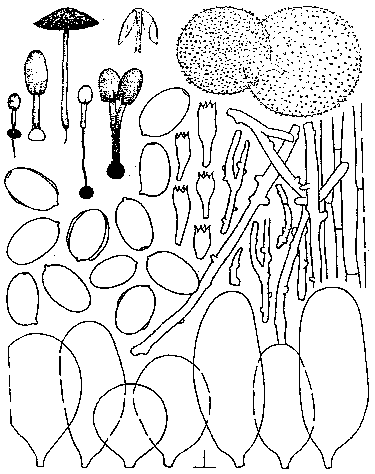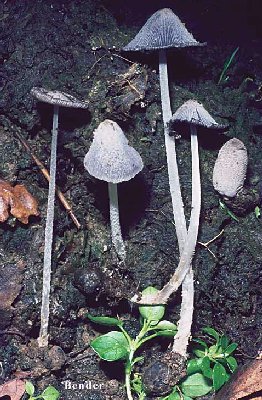Macroscopic features |
Pileus up to 15 x 8 mm when still closed, up to 20(-25) mm when expanded, subglobose to oblong, densely covered with mealy to hairy floccose veil, pale grey to mouse grey. Lamellae, L = 25-40, l = 0-3, free, white to black. Stipe 40-80 x 1-2 mm, whitish; base somewhat clavate and usually connected to a sclerotium. Smell faint or of raw potatoes. |
Microscopic features |
Spores 8.0-11.2 x 5.0-6.4 µm, Q = 1.45-2.00, av. Q = 1.65, av. L = 9.1-9.9 µm, av. B = 5.6-5.9 µm, ellipsoid or ovoid, with rounded base and apex, dark red-brown; germ pore central, 1.2-1.4 µm wide; episporium sparse, smooth, up to 1 µm wide in places. Basidia 10-28 x 6-9 µm, 4-spored, surrounded by 3-5(-6) pseudoparaphyses. Pleurocystidia 30-100 x 22-50 µm, utriform or oblong. Cheilocystidia 20-70 x 18-40 µm, (sub)globose, ellipsoid, oblong or utriform. Pileipellis made up hyphoid elements. Elements of veil up to 100(-125) µm wide, made up of globose, warty cells connected with narrow, diverticulate hyphae. Clamp-connections not found. |
Habitat & distribution |
Rather common, on mixed dung or compost heaps. Wide-spread in Europe. |
Remarks |
The sclerotium is the most useable character to recognize Coprinus tuberosus. If lacking, the species is recognizable by the size of the basidiocarps and the spores with rounded base and smooth, sparse episporium. Only C. foetidellus has similar spores, but that species is very small, up to 7 mm wide when expanding and grows on pure dung. |

[Copyright © by ]

[Copyright © by Hans Bender jbe8995374@aol.com]